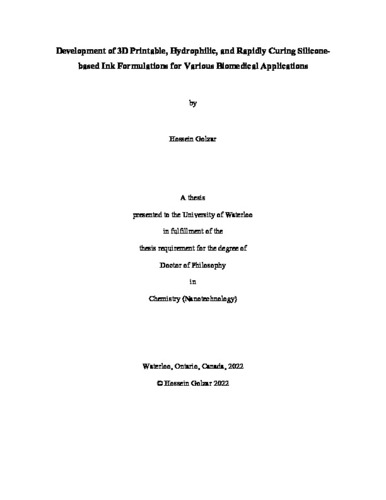| dc.description.abstract | 3D printing is the use of additive manufacturing techniques to deposit materials layer-by-layer. Compared to alternative tissue fabrication methods such as casting, 3D printing is unique, because it uses CT and MRI scans to create the most accurate 3D tissue models. 3D printing of biomimetic structures, especially elastic tissue mimetics, is a relatively young research field and is experiencing exponential growth. Among the four most commonly used 3D printing methods (power-bed fusion, vat polymerization, material-jetting, and material-extrusion), 3D micro-extrusion (ME) is the most suitable method for printing macroscale (centimeter size) and arrayed acellular/cell-laden biomimetic structures with high-throughput due to its capability in multi-material printing and ease of operation. However, for 3D ME printing of precise and functional human-mimetic substitutes, there is a need to develop an appropriate 3D printable ink with tunable mechanical and rheological features. Among different polymers, silicone elastomers have been widely utilized in different biomedical applications due to their remarkable features such as flexibility, adaptability, and biocompatibility, but the slow curing speed, low viscosity, and hydrophobicity of the existing silicones are challenges that hinder silicone applications. In this thesis, we have made an attempt to address these issues by deploying a series of strategies to develop UV-curable and hydrophilic silicone-based inks that can be used to rapidly 3D print a precise articular cartilage (AC) substitute, as a proof of concept. To do so, hydrophilic and rapidly curing (under three seconds) inks, consisting of aminosilicone, cellulose nanocrystal (CNC), and methacrylate anhydride (MA), are developed for the printing of human articular cartilage (HAC) substitutes, with a biomimetic multizonal structure, for the first time. The developed inks are shown to possess a suitable shear-thinning property and tunable mechanical strengths for 3D ME printing. The ability to print high aspect ratio and hemispherical structures without any sacrificial supporting materials is demonstrated. The desired mechanical stiffnesses of HAC layers can be readily achieved by printing with aminosilicone inks containing different CNC and MA concentrations. A multilayered HAC with a gradual increase of the compression modulus from 0.25 to 1.32 MPa for the superficial layer to the deep zone, respectively, is successfully printed. Further, the durability of the 3D-printed HAC against a high repetition rate of cyclic compressions (400 cycles) is evaluated. Additionally, a customized HAC was printed to cover human femoral condyles.
Lastly, we have tried to employ our developed ink for the fabrication of microfluidic devices (MFDs), where silicone elastomers are extensively used. MFDs have grabbed significant interest due to their unique features such as low-cost fabrication, miniaturization, simplicity, and reduced reagent consumption. Compared to conventional MFD fabrication methods, mainly soft lithography, 3D printing has the following advantages: easy geometry customization, multi-material printing, one-step printing, and better device integrity (i.e. no bonding, no leakage). Our results demonstrated that various integrated MFDs with different channel sizes could be readily 3D printed using our developed ink.
Taken all together, this thesis presents a new class of silicone-based ink, with high commercialization readiness levels, that can be used for not only the fabrication of personalized and biocompatible tissue-mimetic models but also 3D printing integrated MFDs in one-step for various biomedical applications. | en |

